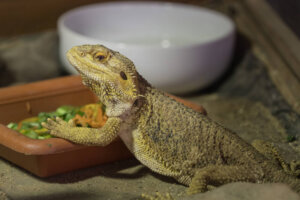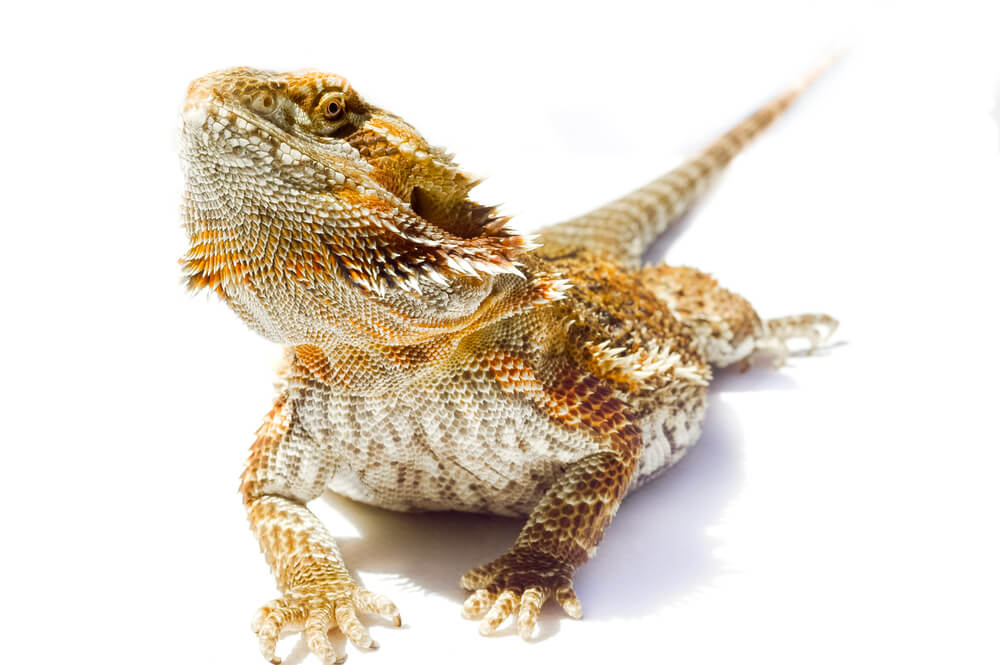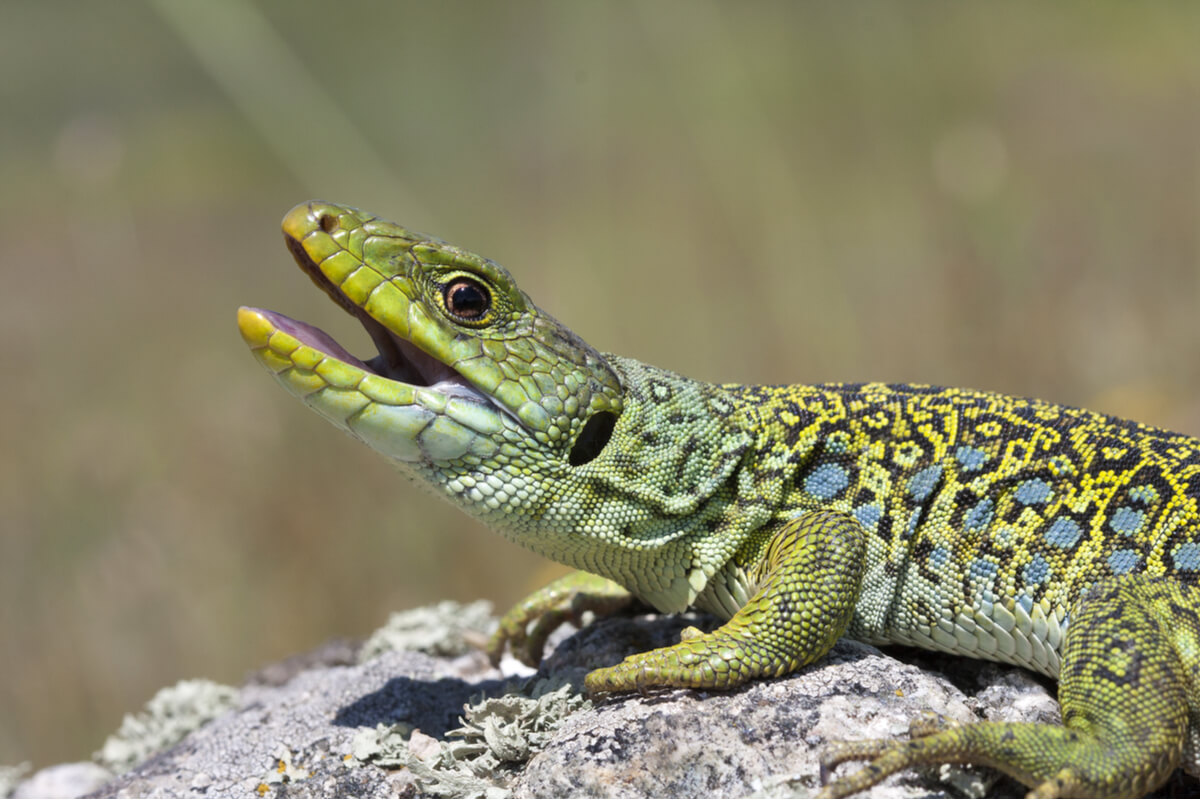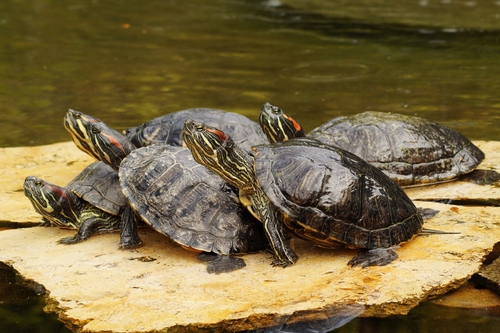Some Fascinating Omnivorous Reptiles!


Written and verified by the biologist Cesar Paul Gonzalez Gonzalez
Reptiles are some of the most peculiar and bizarre vertebrates in existence. In fact, their appearance is often striking and some of them are even kept at home as pets, However, we often encounter problems with their diets, as we aren’t too familiar with what they eat. Like other animals, reptiles can be herbivores, frugivores, carnivores or even omnivores. And in this article we’ve compiled 6 fascinating omnivorous reptiles for you to marvel at!
The reptile group is quite diverse, and it isn’t surprising that each member has a different diet according to its nutritional requirements. Continue reading and discover some wonderful omnivorous reptiles!
What types of diets do reptiles have?
Reptile metabolism is very different from that of other vertebrates, as they need a correct environmental temperature in order to be able to carry out the digestive process. This in itself isn’t enough to completely limit their food selection, but it does affect their food preferences. In general, depending on their diet, reptiles can be classified as follows:
- Herbivores: These feed only on plant matter such as flowers, leaves, stems and roots.
- Carnivores: These feed only on all types of meat.
- Insectivores: These are usually considered a subtype of carnivores that mainly consume small invertebrates, such as insects.
- Frugivores: These are also considered a subtype of herbivores, as they consume fruits.
- Omnivores: A classification that groups together animals that can consume any type of food, from meat and vegetable matter to carrion (decomposing organic matter).
Which reptiles are omnivorous?
Leaves, grasses, and stems are usually one of the most difficult food resources to digest, as they’re composed of fibers that are very resistant to digestion. Because of this, it’s rare for reptiles to be herbivores or omnivores. Even so, there are several species that enjoy adding plant matter to their diet, such as the following.
1. Central bearded dragon (Pogona vitticeps)
The central bearded dragon is a species of reptile known for having pointed scales on its neck, which closely resemble a “beard”. In the wild, they feed on a wide range of resources, including flowers, stems, leaves, fruits, insects, and small rodents.
Because the bearded dragon has a peculiar appearance and is quite small compared to other reptiles, it’s natural for it to be considered a good exotic pet. The only problem is that its diet must be managed very carefully, as an excess of certain foods could be detrimental to its health.

2. Lilford’s wall lizard (Podarcis lilfordi)
Lilford’s wall lizard is a well-known reptile from the islands of Mallorca and Menorca. Although its diet is mainly based on insects and other arthropods, it’s considered more of an opportunistic species. This is because it also consumes pollen, nectar, plants, and even carrion.
3. Ocellated lizard (Timon lepidus)
The ocellated lizard is one of the longest reptiles in Europe, reaching sizes of up to 80 or 90 centimeters in length (32 to 36 inches). Although it prefers to feed on insects, it’s also able to consume berries, fruits, and other large prey such as rodents and even lizards.

4. Uromastyx geyri
Also called Geyr’s spiny-tailed lizard, among other names, this species of lizard is characterized by a wide body and protruding, spiny scales on its tail. The diet of the specimens varies somewhat according to the stage of development of the specimens, when they’re young they have a preference for eating insects, while in adulthood they eat leaves, grains, fruits, and flowers. This doesn’t limit them, as they feed on whatever resources are available at the time.
5. Turtles (Testudines)
The diet of turtles varies somewhat depending on the species. However, as a general rule, terrestrial turtles (tortoises) are herbivorous and aquatic turtles are omnivorous. Of course, most of them have a preference for a specific food, but, as far as chelonians living in the water are concerned, they usually consume algae, mollusks, crustaceans, and fish.

6. Green Iguana (Iguana iguana)
The green iguana is one of the best-known species of the Iguanidae family, which groups together large lizards with semi-arboreal or semi-aquatic habits. Although many consider these animals to be herbivorous, they sometimes consume some invertebrates to supplement their nutritional needs.
As can be seen, the diet of reptiles changes according to the conditions of their habitat and the availability of their resources. In fact, omnivory is an additional strategy to ensure the survival of the species, because, thanks to this, it isn’t restricted to only one type of food. Thus, species have more alternatives to face times of food shortage.
Reptiles are some of the most peculiar and bizarre vertebrates in existence. In fact, their appearance is often striking and some of them are even kept at home as pets, However, we often encounter problems with their diets, as we aren’t too familiar with what they eat. Like other animals, reptiles can be herbivores, frugivores, carnivores or even omnivores. And in this article we’ve compiled 6 fascinating omnivorous reptiles for you to marvel at!
The reptile group is quite diverse, and it isn’t surprising that each member has a different diet according to its nutritional requirements. Continue reading and discover some wonderful omnivorous reptiles!
What types of diets do reptiles have?
Reptile metabolism is very different from that of other vertebrates, as they need a correct environmental temperature in order to be able to carry out the digestive process. This in itself isn’t enough to completely limit their food selection, but it does affect their food preferences. In general, depending on their diet, reptiles can be classified as follows:
- Herbivores: These feed only on plant matter such as flowers, leaves, stems and roots.
- Carnivores: These feed only on all types of meat.
- Insectivores: These are usually considered a subtype of carnivores that mainly consume small invertebrates, such as insects.
- Frugivores: These are also considered a subtype of herbivores, as they consume fruits.
- Omnivores: A classification that groups together animals that can consume any type of food, from meat and vegetable matter to carrion (decomposing organic matter).
Which reptiles are omnivorous?
Leaves, grasses, and stems are usually one of the most difficult food resources to digest, as they’re composed of fibers that are very resistant to digestion. Because of this, it’s rare for reptiles to be herbivores or omnivores. Even so, there are several species that enjoy adding plant matter to their diet, such as the following.
1. Central bearded dragon (Pogona vitticeps)
The central bearded dragon is a species of reptile known for having pointed scales on its neck, which closely resemble a “beard”. In the wild, they feed on a wide range of resources, including flowers, stems, leaves, fruits, insects, and small rodents.
Because the bearded dragon has a peculiar appearance and is quite small compared to other reptiles, it’s natural for it to be considered a good exotic pet. The only problem is that its diet must be managed very carefully, as an excess of certain foods could be detrimental to its health.

2. Lilford’s wall lizard (Podarcis lilfordi)
Lilford’s wall lizard is a well-known reptile from the islands of Mallorca and Menorca. Although its diet is mainly based on insects and other arthropods, it’s considered more of an opportunistic species. This is because it also consumes pollen, nectar, plants, and even carrion.
3. Ocellated lizard (Timon lepidus)
The ocellated lizard is one of the longest reptiles in Europe, reaching sizes of up to 80 or 90 centimeters in length (32 to 36 inches). Although it prefers to feed on insects, it’s also able to consume berries, fruits, and other large prey such as rodents and even lizards.

4. Uromastyx geyri
Also called Geyr’s spiny-tailed lizard, among other names, this species of lizard is characterized by a wide body and protruding, spiny scales on its tail. The diet of the specimens varies somewhat according to the stage of development of the specimens, when they’re young they have a preference for eating insects, while in adulthood they eat leaves, grains, fruits, and flowers. This doesn’t limit them, as they feed on whatever resources are available at the time.
5. Turtles (Testudines)
The diet of turtles varies somewhat depending on the species. However, as a general rule, terrestrial turtles (tortoises) are herbivorous and aquatic turtles are omnivorous. Of course, most of them have a preference for a specific food, but, as far as chelonians living in the water are concerned, they usually consume algae, mollusks, crustaceans, and fish.

6. Green Iguana (Iguana iguana)
The green iguana is one of the best-known species of the Iguanidae family, which groups together large lizards with semi-arboreal or semi-aquatic habits. Although many consider these animals to be herbivorous, they sometimes consume some invertebrates to supplement their nutritional needs.
As can be seen, the diet of reptiles changes according to the conditions of their habitat and the availability of their resources. In fact, omnivory is an additional strategy to ensure the survival of the species, because, thanks to this, it isn’t restricted to only one type of food. Thus, species have more alternatives to face times of food shortage.
All cited sources were thoroughly reviewed by our team to ensure their quality, reliability, currency, and validity. The bibliography of this article was considered reliable and of academic or scientific accuracy.
- Hirth, H. F. (1963). Some apects of the natural history of Iguana iguana on a tropical strand. Ecology, 44(3), 613-615.
- Salem, S. B., Miles, D. B., Alm-Eldeen, A. A., & Kandyel, R. M. (2017). Comparative histological characterization of the tongue in two reptiles, Scincus scincus (Scincidae) and Uromastyx ornata (Agamidae) in relation to diet. Egypt. J. Exp. Biol.(Zool.), 13(2), 319-327.
- Oonincx, D. G. A. B., Van Leeuwen, J. P., Hendriks, W. H., & Van der Poel, A. F. B. (2015). The diet of free‐roaming Australian central bearded dragons (Pogona vitticeps). Zoo Biology, 34(3), 271-277.
- Perez-Cembranos, A., Leon, A., & Perez-Mellado, V. (2016). Omnivory of an insular lizard: sources of variation in the diet of Podarcis lilfordi (Squamata, Lacertidae). PloS one, 11(2), e0148947.
This text is provided for informational purposes only and does not replace consultation with a professional. If in doubt, consult your specialist.








